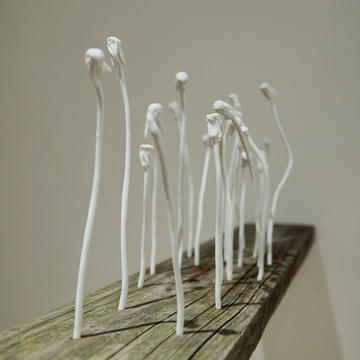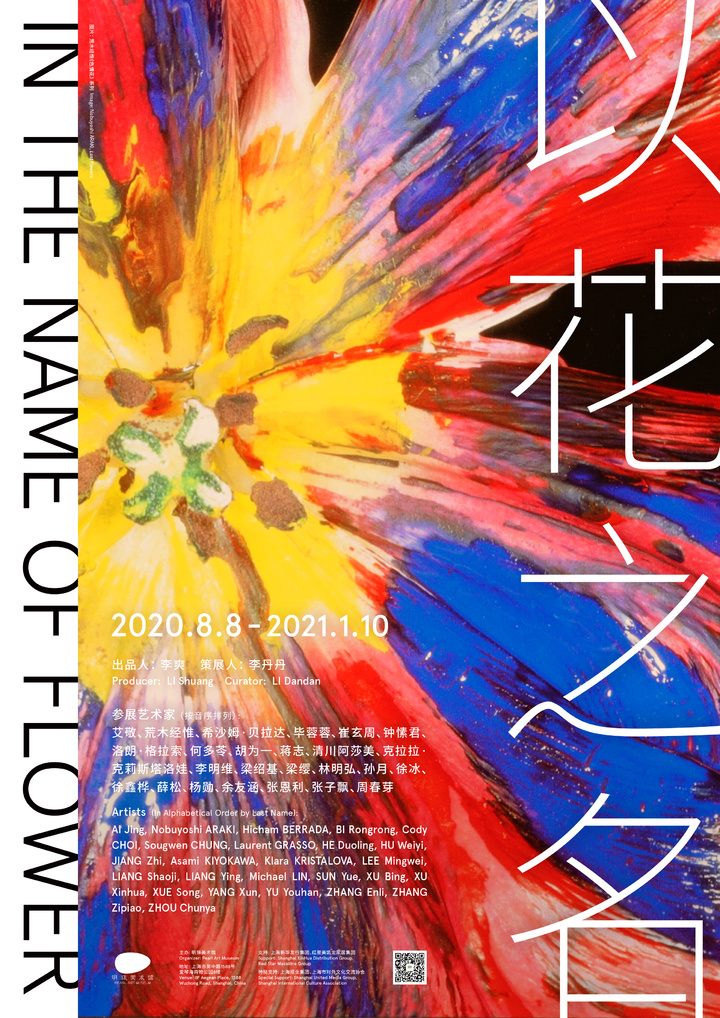
In 2020, the COVID-19 pandemic rages across the world. As a poetic response to such a great challenge, an “emergent gathering” has been arranged in the name of flower and art. Twenty-five contemporary artists around the world attend the exhibition with over 150 flower-themed artworks – there are some newly accomplished works that have not been released yet, and also some masterpieces that are definitely worth seeing. The elements, images, and characteristics of flowers have been presented in unprecedentedly rich ways: they can be concrete, abstract, real, static, dynamic, growing, watchable, touchable, and smellable… The installations of real flowers, the familiar painting-related expressions, and the experimental forms of art have all been properly arranged in a scattered manner. When stepping into the exhibition hall, the audience become an organic part of the artworks immediately and the exhibition as well.
Under the same theme of flower, these contemporary artists have created a rich array of multi-element artworks, which are completely different but closely related to each other. Through this exhibition, the museum wishes to explore new ways and new expressions of artistic languages, to provoke new thinking on the human-nature, interpersonal, and self-relationships, and to propose constructive solutions. Ms. Li Dandan, the director and curator of Pearl Art Museum, said that, “We selected over 150 artworks in total. These artworks constitute a significant part of the art history, and showcase the natural beauty and splendid customs of different places around the world. ‘In the name of flower’, these artists observe, reproduce, create, and meditate. In a poetic manner, they ponder on issues that have confronted human beings from the beginning of time and become the most urgent now, such as art, life, death, lusts, nature, emotions, and future.”
Maurice Maeterlinck (1862-1949), Belgian playwright and poet, wrote in his book The Intelligence of the Flowers: “They create marvels. We shall see that the flower sets man a prodigious example of insubmission, courage, perseverance and ingenuity. If we had applied to the removal of various necessities that crush us, such as pain, old age and death, one half of the energy displayed by any little flower in our gardens, we may well believe that our lot would be very different from what it is.”
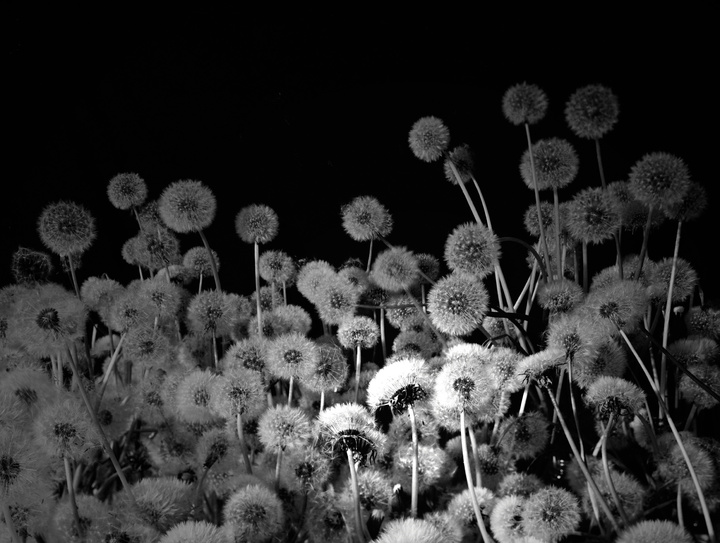
Natural Process Activation #3 Bloom by Hicham Berrada
Plants are powered by seeds that take root deep in the soil and blossom into stunning flowers. The exhibition “In the Name of Flower” held in Pearl Art Museum will usher you in with a black and white film Natural Process Activation #3 Bloom by Hicham Berrada. In this short film, the artist replicates the amazing blooming moment of dandelion, presenting a dynamic process of how plants blossom in time-lapse manner.
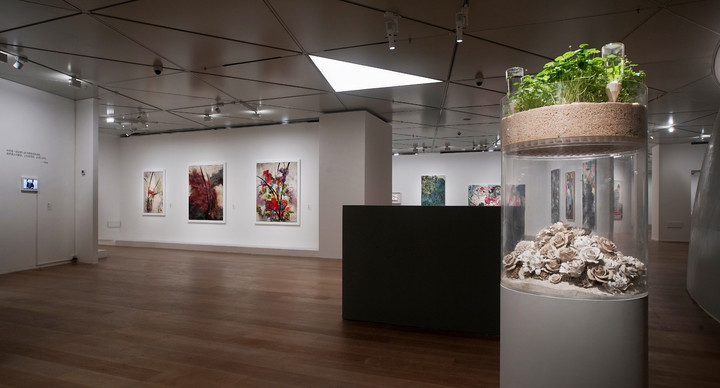
Waiting and Meanwhile by Sun Yue
The dandelion flowers bloom and are gone in an instant, as represented by the artist Sun Yue in her work Whispers of time – fly away and never come back. At the opening ceremony of the exhibition, there was a performance Whispers of time – fly away by Sun Yue, who picked up a bunch of dandelion seeds from one end of a bench that was cut in half, and passed the seeds down to other people. As the seeds were passed down from one to another, they were gradually gone. The performance will be live recorded as a film to be repeatedly played in the exhibition hall. While her other work Whispers of time – never come back, depicting dandelion flower stems with seeds all gone, is represented by the white porcelain-made dandelion on the other half of the bench. It’s just like what Sun Yue said: “I use china clay and plants to visualize the passing of time.” Her other two installation works Waiting and Meanwhile also explore such theme with flowers, green plants, and porcelain, which respectively depicts the withering process of white roses vs. the never-changing porcelain roses, and the increasingly luxuriant loosestrifes vs. the unfired porcelain clay flowers with watering. They all start at the beginning of the exhibition to display the power of time.
Xu Bing’s work American Silkworm Series 3: The Opening also explores the theme of nature, life and time. It displays a bouquet of mulberry leaves consumed by silkworms, changing from lush green to bare branches with golden and silver silkworm cocoons. Liang Shaoji’s photographic works Butterflies, The Snow Butterfly, and Silk Shadow exhibit at the same time also continue to center around time and life, and explore the interaction with nature in the form of silkworm’s life. While Xu Xinhua uses porcelain as a medium, his Life Museum-Flowers series mix sunflowers, roses, lilies and other flowers in china clay and burns them at high temperature, to represent life returning to the soil and keep their traces. Nobuyoshi Araki’s Lust Flowers series of photographs use acrylic paint to color petals, making the withered flowers immortal in bright colors. Thanks to the artist’s keen perspective, rich imagination and unique expression, the nature life appears to be independent of time.
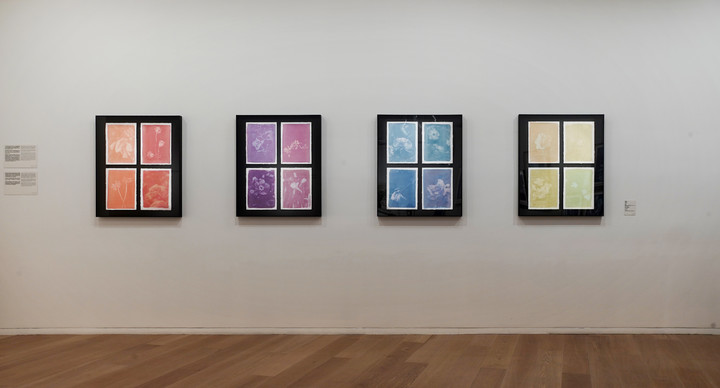
Farewell series by Hu Weiyi
Even for the seemingly familiar flower images, there are usually something extraordinary about them, like Cody Choi’s Noblesse Hybridigeseries, which as the name suggests, adopt both Eastern and Western painting traditions. The series are presented in a mixed style of the Western rococo art and Eastern elegant pattern, with a touch of both oil and ink paining’s texture, and even the modern digital printing technology is used on the artificial marble. In the series, the notion of culture without borders is explicitly displayed. Another example is Laurent Grasso’s Future Herbarium depicted in the way of traditional European oil painting on wood panels, which resembles the early plant illustrations, while in fact depicts the imaginary exotic flowers in the future. In this work, he explores the possibility of future in an old-fashioned way. And in a new series of works Farewell, Hu Weiyi improves the traditional anthotype based on the ancient printing method by using flower juice to make photosensitive emulsion for exposure and development, and record the image before the flower is made into flower juice, in an attempt to extend the lifetime and break technical boundaries.
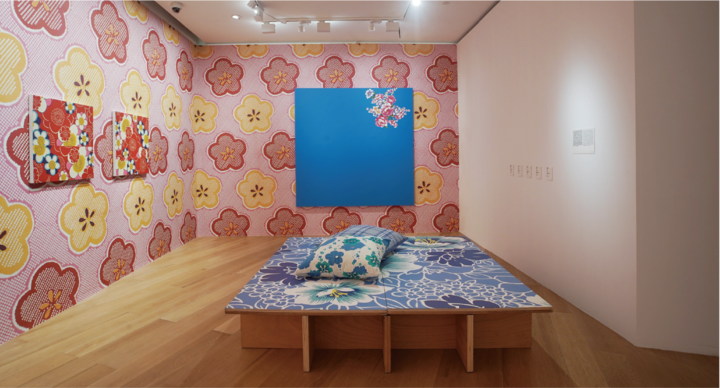
Michael Lin’s Installation Space
To break the boundaries of field, this exhibition sets up three special spaces for the discussion of interaction, growth, love and future. The installation space by Michael Lin is one of such spaces, where he frames it with his well-known magnified conventional fabric pattern, in combination with various artworks, such as wallpaper, painting, and bed. In this way, he creates a novel space different from the past, and presents it as a “state” adapted to different occasions of social activity, interaction and sharing, therefore incorporating art into daily life. As Michael Lin said, “I want to change the way of how people appreciate paintings. Instead, they can step on, lie down, or sit on artworks”. His work fully embodies the key spirit of contemporary art, which is art should go beyond simply being appreciated, and can be instantly experienced, or even touched.
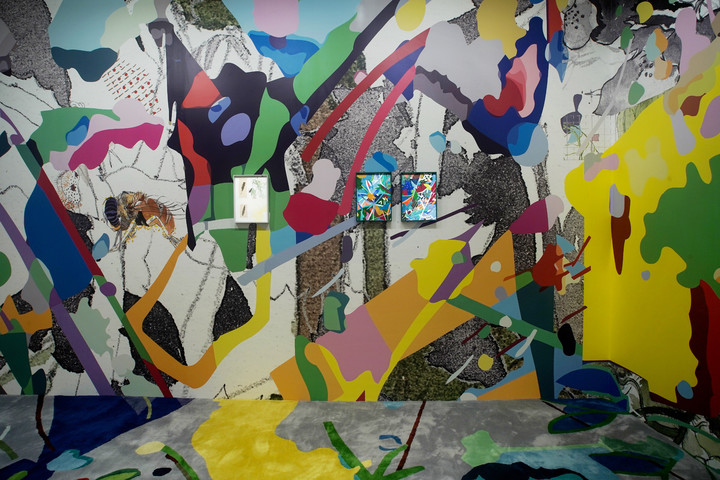
Bi Rongrong’s Installation Space – A Growing Landscape (III)
A Growing Landscape (III) is a semi-open space especially created by Bi Rongrong for Pearl Art Museum, based on the museum’s space features designed by the famous architect Tadao Ando. In this space, colorful manuscripts on display are harmoniously integrated with the extended wallpapers and carpets, and the patterns are derived from the traditional Chinese herbs in close relation with the artist’s personal life. As the artist is physically cured by these herbs, she becomes interested in them, and often listens to the stories of Chines ancient doctors while she paints. With such interest, she transforms what she learns about the herbs into manuscripts. The colorful lines and fragments she depicts in these manuscripts are like wildly growing vines intertwined with the previous works and the architectural space. These manuscripts may not be what they used to be, but they blend into a new environment in a more independent form, and transform as a different landscape.
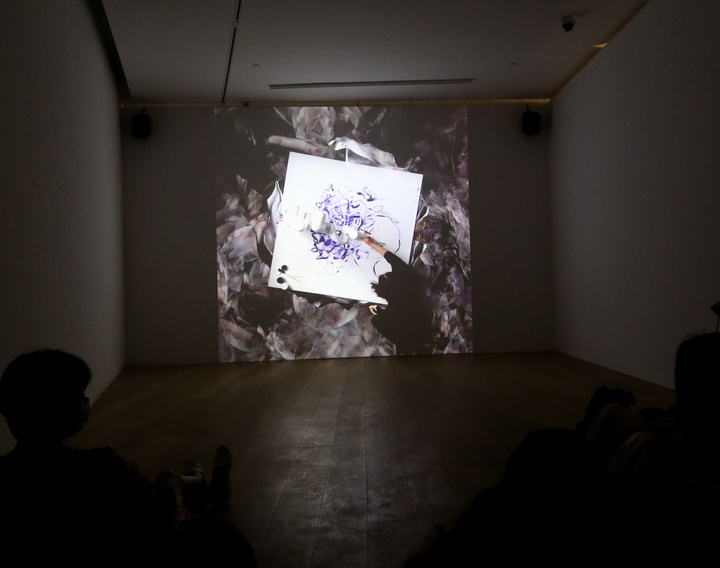
Sougwen Chung’s Performance Installation Film - Flora Rearing Agricultural Network
In another black box space, a performance installation film Flora Rearing Agricultural Network by Sougwen Chung is played, which records how the interdisciplinary artist and pioneer in the field of human-computer collaboration works with her robotic collaborator (AI) to develop the blueprint of making the plant area as agriculture cultivation network during her 66-day isolation. The blueprint is developed for a multi-robot plant-related agricultural network that will be built in 2021. The agricultural network will design a mechanical system close to nature, and use flowers, microbial cells and photosynthesis to provide energy for the machinery. The blueprint serves as the road map of the agricultural system to express the theme of the harmonious relations among human, machine and ecology.
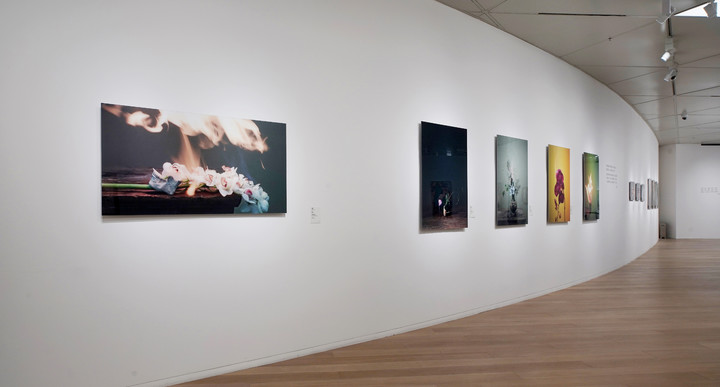
蒋志摄影作品《情书》系列展出现场
Flowers are the miracle of nature and salutation to life. Some just enjoy the beauty of flowers, while some see the cruel twist of fate in them. To some, a garden blazing with flowers “rendered me almost speechless in joy; I want to exclaim but words fail me” (by Yu Pingbo); to some, blazing flowers are like “love letters”, by freezing their ephemeral beauty, the pleasurable flowers and the sorrow brought by their death have also been recorded (Love Letters by Jiang Zhi). The flowers bloom unintentionally and freely, and their meanings are the reflection of human emotions. In this exhibition, there are three installations designed with fresh flowers, among which the most interactive and emotional one is The Moving Garden at the end of the exhibition.
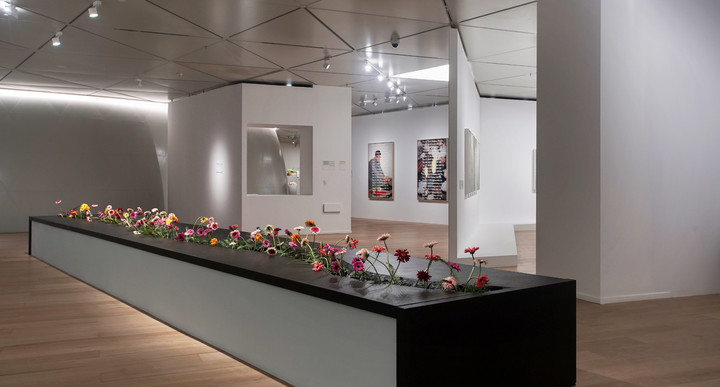
The Moving Garden by Lee Mingwei
Located to the left of the exit, The Moving Garden is a 9-meter-long black granite table with fresh flowers that appear to grow out of a canyon-like incision running down its middle. The interactive installation also includes single blossoms arranged around the incision, which visitors are invited to take when they leave the Museum, on the condition that they make a detour on the way to their next destination and give the flower to a stranger as a gift. The piece continues to explore Lee’s all-time concerns, i.e. giving, intimacy and trust among strangers, which are inspired by his reading of Lewis Hyde’s The Gift: Imagination and the Erotic Life of Property, a book discussing the beneficial effects of artistic works as gifts on both those who give them (artists) and those who receive (the general public). In addition, the sight of hundreds of flowers floating down the Rhône River in spring also inspired him to create the installation that experiments gift-giving acts among strangers.
The flower from the “canyon” given to random passers-by symbolizes a gift from nature, a crystallization of art and a carrier of love and goodwill. By giving gifts and delivering kindness, strangers are brought closer together and a bond is created between them. Who will you give the flower to? How will he or she react? The installation has been exhibited in different countries and the interactions between strangers differed greatly. What will happen in today's Shanghai then? This time Lee uses colorful African daisy. Blooming like sun, the flower represents mutual respect and mutual love, perseverance and fearlessness according to its flower language, which is highly relevant in this time and place. We hope that the sun-like flower will illuminate the shadow and bring glimmers of hope. We'll look ahead to what surprises the flowers will bring.
With the idea of building “an art museum without walls and fluid art academy”, Pearl Art Museum has engaged itself with carefully curated exhibitions, art publishing, as well as online and offline interdisciplinary public education activities, hoping to expand its role as a contemporary cultural and artistic institution, improve its working methods and reach to more areas. With such idea, “In the Name of Flower” has also become a flagship program with the capacity to grow continuously.
During the “In the Name of Flower” exhibition, Pearl Art Museum will launch various public education activities every week under the theme of “flower”, covering a wide range of fields such as art, literature, nature, science and environmental protection. Special activities include lectures on floriculture, botany, aromatherapy, and other topics in literature and art, as well as handicraft workshops attended by the exhibiting artists, which allow participants to experience the artistic techniques and skills featured in the exhibition, for example, cyanotype. In addition, a series of floral art courses are being planned, and field trips are under way, such as flower hunting in botanical gardens and flower planting on farms. Furthermore, the children’s guidebook has been upgraded for this exhibition, and two different versions will be available specifically for children under and over 6 years old respectively. The former features flower identification and coloring, and the latter focuses more on the popularization of science. You can subscribe to our WeChat Official Account “PearlArtMuseum”, where you will find more information and take part in more events.





